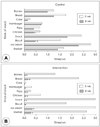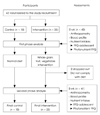Abstract
There is increasing evidence that dietary factors in plant-based diets are important for the prevention of chronic disease. Especially, phytonutrients in fruits and vegetables have been recognized as major contributors for the decreased level of oxidative stress. In this study, the effect of switching the dietary habit to high consumption of fruits and vegetables were evaluated on the parameters of serum antioxidant status in healthy high school students. Forty one students participated in a randomized controlled trial and were assigned to the control group (n = 18) or the intervention group (n = 23). The intervention group was provided for 8 weeks with the main food source being whole grain and vegetables. Anthropometric measurements, blood parameters and dietary intakes were measured, and compared before and after study. After 8 weeks, weight and BMI were significantly decreased in the intervention group (p = 0.000). The serum diacron reactive oxygen metabolites (d-ROMs) test resulted in a significantly decreased level only in the intervention group (p < 0.05) after 8 weeks, but serum biological antioxidant potential (BAP) was increased significantly in both groups (p < 0.001). Intake of energy, total fat, cholesterol and sodium in the intervention group were significantly decreased after 8 weeks (p < 0.05). Also, the intervention group had significantly increased vitamin and phytonutrient intakes of all-trans-β-carotene, α-carotene, α-tocopherol, ascorbic acid, and total phenols (p < 0.05). Overall, the results of this study suggest that whole grain, fruits, and vegetables supplementation showed improvement of the adolescent health.
Figures and Tables
 | Fig. 2Comparison of snacking between 0 week and 8 week by food frequency questionnaire in the control and the intervention group. A: Control group. B: Intervention group. |
Table 1
Comparison of anthropometric measurements between 0 week and 8 week in the control and the intervention group

Table 2
Comparison of Blood profiles between 0 week and 8 week in the control and the intervention group

References
1. Paek KW. Dietary pattern analysis and factors affecting abdominal obesity in children and adolescents. J Korean Soc Sch Health. 2009. 22(2):137–146.
2. Kim GR, Kim MJ. A survey on the dietary behavior of high school students - about regularity of meal and number of meal per day. J Korean Soc Food Sci Nutr. 2011. 40(2):183–195.

3. Ministry of Health and Welfare, The Korea Institute for Health and Social Affairs. The third national health promotion plan (2011-2020) in Korea. 2011. Seoul: The Korea Institute for Health and Social Affairs.
4. Ministry of Health and Welfare. Korea Centers for Disease Control and Prevention. The third Korea National Health and Nutrition Examination Survey (KNH-ANES IV). 2008. Cheongwon: Korea Centers for Disease Control and Prevention.
5. Cho HS, Kim MH, Choi MK. A study on vegetable intakes and dietary habits of middle school students in Chungnam. Korean J Community Nutr. 2010. 15(4):525–535.
6. Choi MK. A study on the relationship between fast food consumption patterns and nutrition knowledge, dietary attitude of middle and high school students in Busan. Korean J Culinary Res. 2007. 13(2):188–200.
7. Johnson F, Wardle J, Griffith J. The adolescent food habits checklist: reliability and validity of a measure of healthy eating behaviour in adolescents. Eur J Clin Nutr. 2002. 56(7):644–649.

8. American Dietetic Association. Dietitians of Canada. Position of the American Dietetic Association and Dietitians of Canada: vegetarian diets. Can J Diet Pract Res. 2003. 64(2):62–81.
9. Büchner FL, Bueno-de-Mesquita HB, Ros MM, Overvad K, Dahm CC, Hansen L, Tjønneland A, Clavel-Chapelon F, Boutron-Ruault MC, Touillaud M, Kaaks R, Rohrmann S, Boeing H, Nöthlings U, Trichopoulou A, Zylis D, Dilis V, Palli D, Sieri S, Vineis P, Tumino R, Panico S, Peeters PH, van Gils CH, Lund E, Gram IT, Braaten T, Sánchez MJ, Agudo A, Larrañaga N, Ardanaz E, Navarro C, Argüelles MV, Manjer J, Wirfält E, Hallmans G, Rasmuson T, Key TJ, Khaw KT, Wareham N, Slimani N, Vergnaud AC, Xun WW, Kiemeney LA, Riboli E. Variety in fruit and vegetable consumption and the risk of lung cancer in the European prospective investigation into cancer and nutrition. Cancer Epidemiol Biomarkers Prev. 2010. 19(9):2278–2286.

10. Holt EM, Steffen LM, Moran A, Basu S, Steinberger J, Ross JA, Hong CP, Sinaiko AR. Fruit and vegetable consumption and its relation to markers of inflammation and oxidative stress in adolescents. J Am Diet Assoc. 2009. 109(3):414–421.

11. Kim JS, Kim HY, Park YK, Kim TS, Kang MH. The effects of green vegetable juice (Angelica keiskei) supplementation on plasma lipids and antioxidant status in smokers. Korean J Nutr. 2003. 36(9):933–941.
12. Kang JY, Kim SY, Lee MS, Ahn HS. Effect of vegetable juice supplementation on serum lipid profile and antioxidant activity in college women. Korean J Community Nutr. 2005. 10(2):183–188.
13. Liu S, Lee IM, Ajani U, Cole SR, Buring JE, Manson JE. Physicians' Health Study. Intake of vegetables rich in carotenoids and risk of coronary heart disease in men: The Physicians' Health Study. Int J Epidemiol. 2001. 30(1):130–135.

14. Buijsse B, Feskens EJ, Moschandreas J, Jansen EH, Jacobs DR Jr, Kafatos A, Kok FJ, Kromhout D. Oxidative stress, and iron and antioxidant status in elderly men: differences between the Mediterranean south (Crete) and northern Europe (Zutphen). Eur J Cardiovasc Prev Rehabil. 2007. 14(4):495–500.

15. Albanes D, Heinonen OP, Taylor PR, Virtamo J, Edwards BK, Rautalahti M, Hartman AM, Palmgren J, Freedman LS, Haapakoski J, Barrett MJ, Pietinen P, Malila N, Tala E, Liippo K, Salomaa ER, Tangrea JA, Teppo L, Askin FB, Taskinen E, Erozan Y, Greenwald P, Huttunen JK. Alpha-Tocopherol and beta-carotene supplements and lung cancer incidence in the alpha-tocopherol, beta-carotene cancer prevention study: effects of base-line characteristics and study compliance. J Natl Cancer Inst. 1996. 88(21):1560–1570.

16. Omenn GS, Goodman GE, Thornquist MD, Balmes J, Cullen MR, Glass A, Keogh JP, Meyskens FL, Valanis B, Williams JH, Barnhart S, Hammar S. Effects of a combination of beta carotene and vitamin A on lung cancer and cardiovascular disease. N Engl J Med. 1996. 334(18):1150–1155.

17. Duthie SJ, Jenkinson AM, Crozier A, Mullen W, Pirie L, Kyle J, Yap LS, Christen P, Duthie GG. The effects of cranberry juice consumption on antioxidant status and biomarkers relating to heart disease and cancer in healthy human volunteers. Eur J Nutr. 2006. 45(2):113–122.

18. Basu A, Imrhan V. Tomatoes versus lycopene in oxidative stress and carcinogenesis: conclusions from clinical trials. Eur J Clin Nutr. 2007. 61(3):295–303.

19. Palmieri B, Sblendorio V. Oxidative stress tests: overview on reliability and use. Part II. Eur Rev Med Pharmacol Sci. 2007. 11(6):383–399.
20. Trotti R, Carratelli M, Barbieri M, Micieli G, Bosone D, Rondanelli M, Bo P. Oxidative stress and a thrombophilic condition in alcoholics without severe liver disease. Haematologica. 2001. 86(1):85–91.
21. Yim KS, Lee TY, Park HS. The development and validation of a food frequency questionnaire to assess diets of Korean adolescents. Korean J Community Nutr. 2003. 8(2):149–159.
22. Cho YS. Evaluation of phytonutrients and antioxidant activities of Korean vegetables, fruits and legumes [dissertation]. 2006. Seoul: Yonsei University.
23. Research Institute of Food and Nutritional Sciences, Yonsei University. Phytonutrient contents in vegetable/fruits/legumes. 2009. Seoul: Shinkwang.
24. Barnard ND, Scialli AR, Turner-McGrievy G, Lanou AJ, Glass J. The effects of a low-fat, plant-based dietary intervention on body weight, metabolism, and insulin sensitivity. Am J Med. 2005. 118(9):991–997.

25. Hebbelinck M, Clarys P, De Malsche A. Growth, development, and physical fitness of Flemish vegetarian children, adolescents, and young adults. Am J Clin Nutr. 1999. 70:3 Suppl. 579S–585S.

26. Larsson CL, Johansson GK. Young Swedish vegans have different sources of nutrients than young omnivores. J Am Diet Assoc. 2005. 105(9):1438–1441.

27. Cho JH, Kim MK, Kim SH, Cho SW, Park YK. Association between hair mineral content and nutritional status in vegetarians and non-vegetarians. Korean J Nutr. 2011. 44(3):203–211.

28. Hunt JR. Bioavailability of iron, zinc, and other trace minerals from vegetarian diets. Am J Clin Nutr. 2003. 78:3 Suppl. 633S–639S.

29. Davey GK, Spencer EA, Appleby PN, Allen NE, Knox KH, Key TJ. EPIC-Oxford: lifestyle characteristics and nutrient intakes in a cohort of 33 883 meat-eaters and 31 546 non meat-eaters in the UK. Public Health Nutr. 2003. 6(3):259–269.
30. Tylavsky FA, Spence LA, Harkness L. The importance of calcium, potassium, and acid-base homeostasis in bone health and osteoporosis prevention. J Nutr. 2008. 138(1):164S–165S.

31. Cornelli U, Terranova R, Luca S, Cornelli M, Alberti A. Bioavailability and antioxidant activity of some food supplements in men and women using the D-Roms test as a marker of oxidative stress. J Nutr. 2001. 131(12):3208–3211.

32. Lubrano V, Vassalle C, L'Abbate A, Zucchelli GC. A new method to evaluate oxidative stress in humans. IBS. 2002. 17(3):172–175.

33. Byun S, Kim JY, Cho SH, Kim JW, Hwang WW. The relationship between stress response and oxidative stress among healthy volunteers. Korean J Orient Prev Med. 2009. 13(2):27–38.
34. Vassalle C, Novembrino C, Maffei S, Sciarrino R, De Giuseppe R, Vigna L, de Liso F, Mercuri A, Bamonti F. Determinants of oxidative stress related to gender: relevance of age and smoking habit. Clin Chem Lab Med. 2011. 49(9):1509–1513.

35. Ishii T, Ohtake T, Okamoto K, Mochida Y, Ishioka K, Oka M, Maesato K, Ikee R, Moriya H, Hidaka S, Doi K, Noiri E, Fujita T, Kobayashi S. Serum biological antioxidant potential predicts the prognosis of hemodialysis patients. Nephron Clin Pract. 2011. 117(3):c230–c236.

36. Kakita H, Hussein MH, Daoud GA, Kato T, Murai H, Sugiura T, Mizuno K, Yamada Y, Ito T, Fukuda S, Kato I, Suzuki S, Togari H. Total hydroperoxide and biological antioxidant potentials in a neonatal sepsis model. Pediatr Res. 2006. 60(6):675–679.

37. Ferdowsian HR, Barnard ND. Effects of plant-based diets on plasma lipids. Am J Cardiol. 2009. 104(7):947–956.

38. Park HJ, Lim SJ. Frequency of irritable bowel syndrome, perceived stress, and mental health among women. J Korean Acad Adult Nurs. 2008. 20(5):685–696.




 PDF
PDF ePub
ePub Citation
Citation Print
Print





 XML Download
XML Download